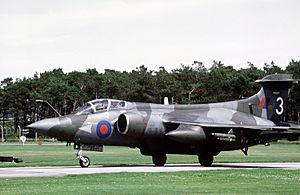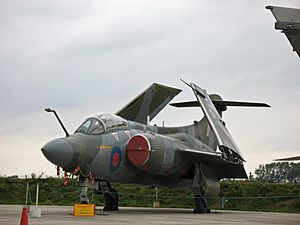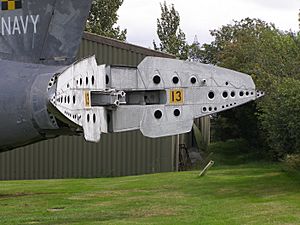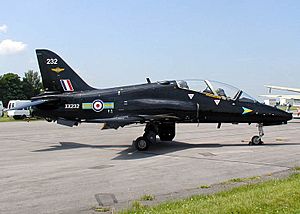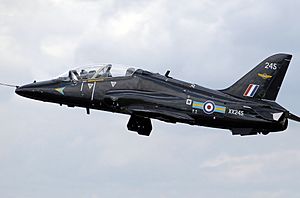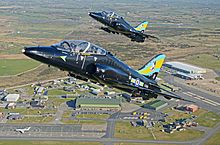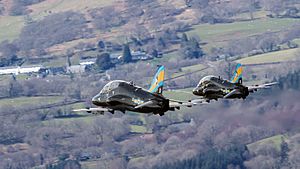No. 208 Squadron RAF facts for kids
Quick facts for kids No. 208 Squadron RAF |
|
|---|---|
| Active | 26 October 1916 – 7 November 1919 1 February 1920 - 30 March 1959 1 April 1959 - 10 September 1971 1 March 1974 - 31 March 1994 1 April 1994 -13 April 2016 |
| Country | |
| Branch | |
| Role | Advanced flying training Instructor training Conversion training |
| Base | RAF Valley |
| Nickname(s) | The Flying Shuftis |
| Motto(s) | Vigilant |
| Aircraft | BAE Systems Hawk |
| Battle honours | Western Front 1915-1918* Arras* Ypres 1917* Lys Somme 1918* Egypt and Libya 1940-1942* Greece 1941* Iraq 1941 Syria 1941 El Alamein* Italy 1944-1945* Gustav Line Gothic Line Gulf 1991* Honours marked with an asterisk* are those emblazoned on the Squadron Standard |
| Commanders | |
| Notable commanders |
Geoffrey Rhodes Bromet |
| Insignia | |
| Squadron Badge heraldry | A sphinx affrontée proper The Gizah Sphinx commemorated the Squadron's long association with Egypt during the inter-war years. An unofficial 'winged eye' badge had been in use from July 1930 until 1937. |
| Squadron roundel |  |
| Squadron Codes | GA (Apr 1939 - Sep 1939) RG (Mar 1944 - 1949) S (Carried on Buccaneers) D (1994 - present) |
No. 208 (Reserve) Squadron was a special unit of the Royal Air Force (RAF). It was last based at RAF Valley in Anglesey, Wales. The squadron used BAe Hawk aircraft to train pilots. It was part of No. 4 Flying Training School RAF. The squadron was closed down in April 2016. This happened in its 100th year of service. The Hawk T.1 planes it used were older than the new Hawk T.2 planes used by another unit, 4(R) Sqn.
Contents
History of the Squadron
World War I: Early Days
The squadron started on October 25, 1916, in Dunkirk, France. It was first called No. 8 (Naval) Squadron and was part of the Royal Naval Air Service. In its early days, the unit flew planes like the Sopwith Pup and Nieuport Scouts. Later, it got Sopwith Camel planes. Their job was to help spot targets for artillery (big guns).
When the Royal Air Force was created on April 1, 1918, the unit became No. 208 Squadron RAF. After World War I ended, the squadron stayed in France for a while. It then returned to the UK and was officially closed on November 7, 1919. During the war, the squadron was very successful, claiming many enemy aircraft. Many skilled pilots, known as aces, served with them.
Between the World Wars
No. 208 Squadron started up again on February 1, 1920, in Egypt. It was first equipped with RE8 planes. From 1920 to 1930, they flew Bristol Fighters. In 1922, the squadron went to Turkey for a year during a time of tension. After that, they returned to Egypt.
In 1930, they received Armstrong Whitworth Atlas aircraft. Five years later, these were replaced by Audaxes. Just before World War II began in 1939, they started using Westland Lysander planes.
World War II: North Africa and Italy
When World War II began, No. 208 Squadron was still in Egypt. They joined the war in mid-1940. They flew Westland Lysander planes for scouting and Hawker Hurricane fighters to help ground troops. This was during the North African Campaign and the Greek Campaign in 1941. Many pilots from Australia and South Africa also served with the squadron.
Later, the unit was stationed in Palestine. They then went back to North Africa. They briefly used Curtiss Tomahawks. But in late 1943, they received Supermarine Spitfires. They flew these famous planes for the rest of the war. From 1944, they took part in the Italian Campaign.
After World War II: New Challenges
After World War II, 208 Squadron moved back to Palestine. They were involved in actions against the Egyptian Air Force. In 1948, the squadron moved to the Egyptian Canal Zone. They saw action in the 1948 Arab-Israeli War. During this time, they lost four Spitfires in fights with Israeli Air Force planes.
On May 22, 1948, a pilot from 208 Squadron, Fg Off Tim McElhaw, shot down two Egyptian Spitfires. This was one of the last recorded "air-to-air fighter pilot kills" using only bullets.
In 1951, the squadron moved to RAF Fayid. Their Spitfires were replaced with Gloster Meteor jet planes. They moved around to different bases, including RAF Takali in Malta. The squadron was closed down in January 1958. However, it started up again the same month in the UK. In March 1958, they got Hunter FMk 6 planes and returned to the Middle East. The squadron was closed again on March 31, 1959.
The very next day, April 1, 1959, it started again in Kenya. It then moved to RAF Khormaksar in Aden in 1961. The squadron stayed in the Middle East until September 1971. It was closed down as Britain reduced its military presence "East of Suez."
Flying Buccaneers: Strike Missions
In 1974, 208 Squadron started up again at RAF Honington. They flew Blackburn Buccaneer S2s. Their job was to fly low and attack enemy targets. The squadron's twelve Buccaneers were ready for action from 1975. They could carry nuclear weapons if needed. Their mission was to support ground forces by attacking enemy positions and supplies.
The squadron continued this role until late 1983. Then, they moved to RAF Lossiemouth. Here, they focused on attacking targets at sea. They flew alongside No. 12 Squadron RAF. The squadron stopped carrying nuclear weapons in late 1993. It was one of the last squadrons to use the Buccaneer before the plane was retired in 1994. After that, the squadron was closed again on March 31, 1994.
Transition to Hawk: Training Pilots
208 Squadron started up once more on April 1, 1994. It became part of No. 4 Flying Training School RAF at RAF Valley. Here, they operated the BAe Hawk aircraft. The school had two squadrons: 208 Squadron with the Hawk T Mk1 and No. 4(R) Squadron with the newer Hawk T Mk2.
Both squadrons trained pilots for advanced jet flying and tactical weapons. This prepared pilots to fly front-line jets like the Tornado or Typhoon. 208(R) Squadron's Hawk tasks included:
- Advanced Flying Training: Teaching new pilots to fly jets and use weapons.
- Instructor Training: Training experienced pilots to become flying instructors.
- Conversion Training: Helping qualified pilots learn to fly the Hawk. This also included training pilots for the famous Royal Air Force Aerobatics Team.
Incidents and Accidents
On April 20, 2007, a BAE Hawk from the squadron crashed near RAF Mona. The pilot was taken to the hospital but was discharged soon after. The accident happened because a student pilot stalled the aircraft during a practice landing.
Centenary and Disbandment
Even though 208(R) Squadron trained pilots alongside the newer Hawk TMk2 aircraft, the Royal Air Force decided to close it down in January 2016. This was because the other squadron, 4(R) Squadron, could handle all the training.
The squadron celebrated its 100th birthday on April 1, 2016. They had a final graduation for students and a special dinner. Soon after, the squadron was officially closed. Its last flight was on April 13, 2016. Three Hawk aircraft, two with special centenary markings, flew over important places linked to the Hawk TMk1. It is estimated that over 1,000 student pilots were trained in the 208(R) Squadron building during its 22 years at RAF Valley.
Aircraft Operated by the Squadron
No. 208 Squadron flew many different types of aircraft throughout its history. Here are some of the main ones:
- World War I: Sopwith Camel, Sopwith Pup, Nieuport Scout
- Between Wars: Bristol F2 Fighter, Armstrong Whitworth Atlas, Hawker Audax, Westland Lysander
- World War II: Hawker Hurricane, Curtiss Tomahawk, Supermarine Spitfire
- After WWII & Cold War: Gloster Meteor (jet), Hawker Hunter (jet), de Havilland Venom (jet), Blackburn Buccaneer (jet)
- Training Role: BAe Hawk (jet trainer)


